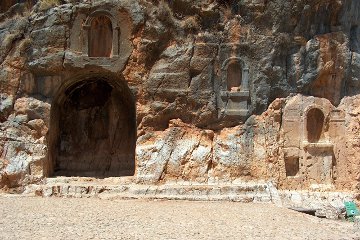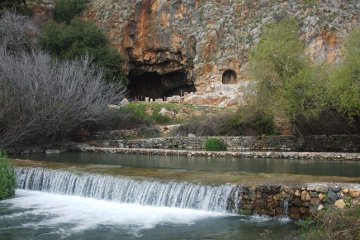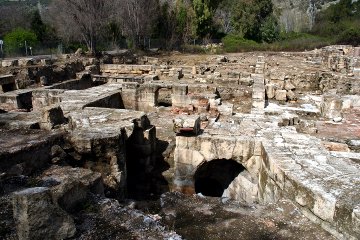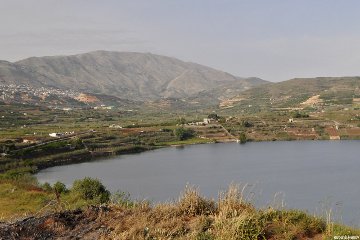Pan's City
| Banias | 33 14 46.83N 35 41 32.13E | The coordinates are for Herod's recently discovered palace. The cave and shrine are a short distance NNE. |
| Berekhat Ram | 33 13 57.26N 35 46 00.17E | The volcanic crater lake thought by Herod Philip to the true source of the Jordan. |
"Banias, the Lost City of Pan" is a new book by John Francis Wilson (I. B. Taurus, 2004) that deals with what is truly a fascinating place in northern Israel. The site is wild enough to please the most romantic soul - a green oasis at the foot of towering Mt Hermon whose eternal snows can be seen on a clear day. Nearer to hand is a dramatic castle perched on a precipitous summit, Qa'alat Nimrod, whose mighty walls kept the Crusaders at bay and only fell before the irresistible onslaught of the Mongols.

| |
| Some of the many shrines cut into the cliff-face at Panias. Each one original held a statue of a divinity honoured at the site. |
It seems rather strange that it was to this heathen centre of Caesarea Philippi that Jesus took his disciples to extract from them a confession that he was the Messiah, "the Son of the living God" (Matthew 16:16), and it was here that he gave to Peter the keys of his kingdom.
The first thing you see as the approach the site is a cliff with a dramatic cavern in its face. From the entrance gate it truly looks like Josephus' description:
"At the base of the cliff is an opening into an overgrown cavern; within this, plunging down to an immeasurable depth, is a yawning chasm, enclosing a volume of still water, the bottom of which no sounding-line has been found long enough to reach."
Alas, when you climb up to the cave it is very disappointing. Not only is the cave entirely lacking in depth, but also whatever pool there may have been once upon a time has been filled in with boulders - I suspect by earthquakes shaking down the ceiling of the cave. However, ranged in front of the cliff face there are the remains of a series of temples, each one marked by a niche carved into the solid rock, where the cult image of the god or goddess once stood.
Pan, of course, was the chief god and the cave was dedicated to him. There were also temples to Zeus, to Nemesis and the nymph Maia as well as an Aseklepion. No doubt other temples await the archaeologist's attention.

| |
| The source of the Jordan is a spring that rises just below the Cave of Pan. |
The reason for this plethora of divinities is at the base of the cliff where a great gushing of water forms the source of the Jordan River. Within 150 feet of the cliff face a dozen small springs coalesce into a stream of clear, cold water that is 10 feet across and would be up to your knees if you tried to wade across it.
Pan was the god of nature and of wild things, and if the sight of all that water in such a thirsty land was not enough to delight the pilgrim, there was a further attraction in the form of a flock of sacred goats dedicated to Pan. At certain times of day a priest would bring four or five of these goats to a podium and play his panpipes to them. At once the goats (no doubt carefully trained!) would get up on their hind legs and begin to dance. Onlookers were convinced that the god himself was inspiring them with a divine frenzy.

| |
| The ruins of Herod's underground palace at Banias. |
After the death of Herod the Great his kingdom was divided among his three surviving sons and Herod Philip received the region north of Galilee. He chose Paneas as his new capital city and began to build a massive palace there. As a compliment to the Roman emperor he called the city "Caesarea", but as there were already a dozen or so Caesareas, this one was distinguished with his own name - Caesarea Philippi.
Philip's palace, which has only recently been discovered, was a huge complex of stone buildings whose main entrance was guarded by two massive drum towers. Water from the springs was channelled through the palace so that it kept the place deliciously cool despite the heat outside - though it can't have done much for Philip'a rheumatism when winter came!
According to Josephus, Philip conducted the first experiment to determine the true source of the Jordan. He decided it must be a circular volcanic lake called Berekhat Ram about five miles east-bsouth-east of Paneas and ordered that chaff be thrown in the lake. When the chaff reappeared at Paneas everyone assumed the king was correct. In fact, there is no connection between the two - an adroit courtier ensured the verification of the royal hypothesis!

| |
| The volcanic crater lake of Berekhat Ram, which some thought to be the source of the Jordan River. |
Philip ruled from 4 BC to AD 34 and was the best of the Herodian rulers. The historians of his time report nothing evil of him and he is remembered as being both generous and just.
Agrippa II (ruled AD 54-68) further enriched the city and tried to name it after his patron Nero, but the new title did not take. The city was such a wonderful pleasure ground that Titus and the Roman army spent a long time there celebrating their victory after the capture of Jerusalem in AD 70. According to Josephus, "many of the [Jewish] prisoners perished here, some thrown to wild beasts, others forced to meet each other in full-scale battles." (Wars of the Jews 7:24)
Wilson's book tells the story of Banias (the modern corruption of the name "Paneas") from the earliest times when a Canaanite fertility god was identified by Greek settlers with their god Pan, down to the time when Christianity triumphed and the pilgrim centre of Pan sank to being a minor provincial town.
Along the way Wilson tells a number of interesting stories, including the visit to the shrines by the Syrian emperor Elagabalus, who brought - or was brought by - two of his wives who were anxious for an heir. Unfortunately Elagabalus was more interested in dressing up as a woman than he was in getting into bed with one, and despite a great "Festival of Pan" held in AD 220, the women had to go home childless.
Unfortunately the book is not only expensive (£27.50 in the UK but the glossy pictures that might justify the price are rather badly printed. If you want to view the shrines of Banias for yourself, you could purchase our new DVD "The Woman from Banias" from our on-line shop. You can view the complete 30 minute film in poor quality web-video on www.nwtv.co.uk under Travel/Middle East.
The alternative to all this virtual travel, of course, is to come on one of our tours, for we try to visit northern Israel and Banias every second or third year. If you are particularly interested in Banias, use our contact page to let us know.





